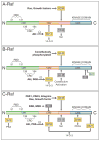Targeting the MAPK-RAS-RAF signaling pathway in cancer therapy
- PMID: 22239440
- PMCID: PMC3457779
- DOI: 10.1517/14728222.2011.645805
Targeting the MAPK-RAS-RAF signaling pathway in cancer therapy
Abstract
Introduction: The MAPK pathway comprises several key signaling components and phosphorylation events that play a role in tumorigenesis. These activated kinases transmit extracellular signals that regulate cell growth, differentiation, proliferation, apoptosis and migration functions. Alteration of the RAS-RAF-MEK-ERK-MAPK (RAS-MAPK) pathway has been reported in human cancer as a result of abnormal activation of receptor tyrosine kinases or gain-of-function mutations mainly in the RAS or RAF genes. These pathways are considered potential therapeutic targets for cancer treatment. Recently, several small-molecule inhibitors targeting this pathway have been developed and are currently being tested in clinical trials.
Areas covered: The biological role of the RAS-MAPK pathway, the consequence of its disregulation and the development of small-molecule inhibitors. The rationale for targeting the RAS-MAPK pathway and the application and the results of various inhibitory molecules as anticancer agents in clinical trials.
Expert opinion: Inhibitors of MEK and particularly of RAF kinases have shown effectiveness in clinical trials with manageable side effects. RAS and BRAF genes need to be analyzed for mutations as markers of response to treatments and to avoid paradoxical effects. Further characterization of the RAS-MAPK molecular mechanisms regulation in malignant cells or underlying the acquired resistance to RAF inhibitors will facilitate development of novel combination therapies.
Figures


References
-
- Harvey JJ. An unidentified virus which causes the rapid production of tumours in mice. Nature. 1964;204:1104–5. - PubMed
-
- Kirsten WH, Schauf V, McCoy J. Properties of a murine sarcoma virus. Bibl Haematol. 1970;(36):246–9. - PubMed
-
- Cooper GM. Cellular transforming genes. Science (journal) 1982;217:801–6. - PubMed
-
- Santos E, Tronick SR, Aaronson SA, et al. T24 human bladder carcinoma oncogene is an activated form of the normal human homologue of BALB- and Harvey-MSV transforming genes. Nature. 1982;298:343–7. - PubMed
Publication types
MeSH terms
Substances
Grants and funding
LinkOut - more resources
Full Text Sources
Other Literature Sources
Research Materials
Miscellaneous
